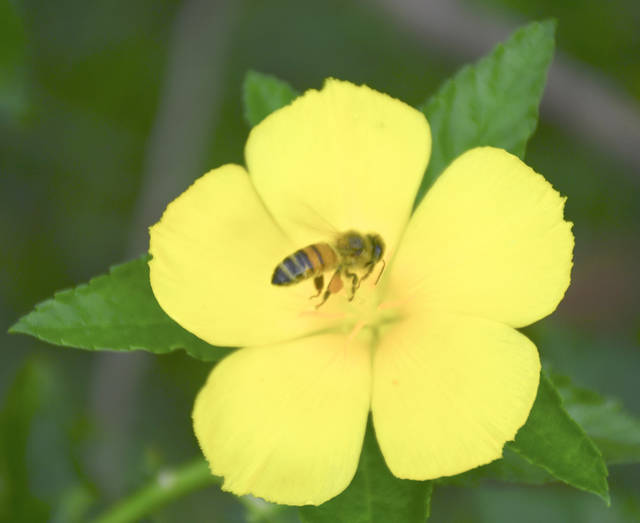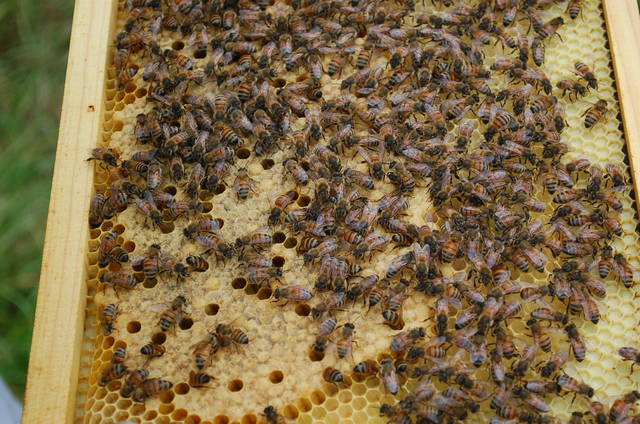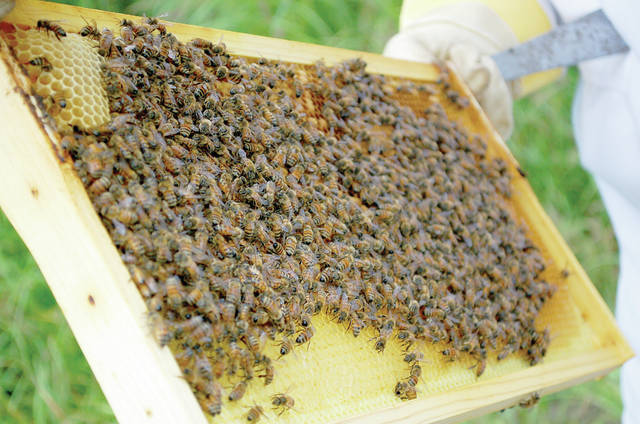Kauai bees are bringing more than just pollen back into their hives when they return from foraging, according to a recently released, peer-
reviewed study published by Kauai scientists.
Glyphosate, also known as Roundup, was in about one-third of honey sampled from store shelves on the island. It was also found in 27 percent of the 59 hives sampled island-wide.
“I did the scientific study to answer the question: Are there pesticides in the environment and how (is it spread),” said Carl Berg, who authored the study with researchers Peter King, Glenda Delenstarr, Ritikaa Kumar, Fernando Rubio and Tom Glaze.
He continued: “Yes. We did find it here on Kauai in the honey from the hives and on the shelves in the store, and it’s closely correlated to large-scale agriculture, which we would assume would be the largest users of Roundup.”
Roundup is also used to control weeds on Kauai’s golf courses, resorts and along the highway, and Berg said those could all be locations where the bees are getting the glyphosate, depending on the location of the hive.
The study also looked at concentration of the herbicide in honey and found the highest concentrations on the Westside, with numbers as high as 179 parts per billion in a sample from a hive.
There is no tolerance limit for glyphosate in honey in the United States. In the European Union, the tolerance level is 50 parts per billion.
“Kilauea is rural and suburbs and open forest and there were no pesticides (in samples) there,” Berg said. “Koloa — it’s suburbs and golf and resort and agriculture and suddenly we get 33 percent of our samples have glyphosate in them.”
The study kicked off with a 2015 science project Kumar did, looking at glyphosate concentration in honey. After she left the island to go to university, Berg continued the research.
He used a new technique called the ELISA technique, developed by Rubio, which is a testing method that is more cost effective than the $500 per sample cost of the traditional testing methods.
“We were looking at glyphosate in water and found it was really expensive to do the tests for glyphosate,” Berg said.
With a more cost-effective way of testing for the pesticide in honey, Berg and his fellow researchers tested the 59 hives and mapped them using geospatial mapping.
They were able to assign land use to the foraging areas around the hives they sampled, which is about a 1 kilometer radius from the hive, and map what type of activities were occurring around each of the hives sampled.
It was Westside hives, closest to seed company and large-scale agriculture operations, that had the most glyphosate. And those hives had the highest concentration of the pesticide in their honey.
Berg said the study wasn’t meant to address questions about the effects of glyphosate in honey or attack any industry. He just wanted to find out if the chemical is being transferred off the fields where it has been sprayed and into the hives and then the honey humans eat.
“Seed crops are using a lot of pesticides,” Berg said. “You can choose where you put your hive and you can draw a circle around where you want to put your bees and see what’s in the circle.”
While Berg and his colleagues have been studying honey and testing for glyphosate, results from a 2014 state-led and County of Kauai commissioned study of the island’s bee pollen showed none of Roundup’s active ingredient.
That’s because the researchers didn’t test for it. Danielle Downey, the state’s apiarist at the time, advised against it.
“She’ll tell you she didn’t test for it because the bees don’t react to it,” said Scott Enright, chairperson of the Department of Agriculture. “Danielle gave them (Hawaii’s bees) a clean bill of health.”
Berg says he wasn’t out to answer the question about the effects of glyphosate on bee health or human health, but to answer the question about the presence of the chemical in hives.
The County of Kauai paid $15,000 for the 2014 study of pollen and wax in hives, but its question was a little bit different than Berg’s. The study looked at the presence of restricted use pesticides in pollen and asked whether the bees were being adversely affected by agriculture pesticide use.
In 2017, Enright reported on the study to County
of Kauai.
“The study shows this is not the case,” he told the Kauai County Council during that report.
The 200 individual samples from the 2014 study did show trace amounts of restricted use pesticides like fipronil, which is found in pest control products, though.
While the broad strokes were given to the County of Kauai and announced in public, the data and specifics of the study were given only to the beekeepers who participated in the study.
That’s because it would put the beekeepers’ businesses in jeopardy if it were to be released there were trace amounts of chemicals in their honey.
“It was always stated that we weren’t going to release everybody’s results to the public,” he said.
Downey doesn’t work for the Hawaii DOA anymore: she’s moved on to other apiary-oriented projects, but confirmed each of the 25 participants were provided with complete results of their samples when analysis was done.
“I can say that from the earliest planning stages, protecting the privacy of the beekeepers who agreed to participate by providing pollen samples for the study was of the utmost importance for the project,” Downey said.
•••
Jessica Else, environment reporter, can be reached at 245-0452 or at jelse@thegardenisland.com.





heartbreaking news. And where is Monsanto?
Oh jeez. Firstly you say it was “peer reviewed” but never once mention what scientific journal it was published in. Sounds more like “friends reviewed” to me. Second Rubio didn’t invent ELISA – it’s a very commonly used technique using an immunoassay. And if he’s claiming to have created an ELISA test for glyphosate then that would need to be a tested extensively to verify it’s actually detecting only Roundup. And of *course* it will be possible to detect Roundup in these tiny nanogram amounts because it’s still being used by farmers and homeowners. You could use a sensitive test to detect almost anything you want- is there radioactive material from Fukushima on Kauai? In tiny tiny amounts, yes! But you’re hit with hundreds times more gamma rays from the sun each day so what’s the point? Honestly this is more of catastrophizing that the north shore woot woot love to do. What now? Is the world about to end? Should we only buy mainland honey now? As a real scientist, the stuff that passes here for science is embarrassing. Tell us what journal published this study or guess what ? It’s fake news.
Of course, Carl doesn’t actually know where bees are picking up the glyphosate — they can forage a mile or more from the hive — but he’s so quick to blame agriculture. As for Kilauea, he doesn’t mention that the state found fungicides from the greenhouses and nurseries in pollen collected there.
And where was this study published? A peer reviewed journal, or a pay for play journal? Seems dubious that one of the authors is the guy who invited the test kit and stands to profit from its use.
Too bad Carl started this study with the publicly professed goal of seeking a ban on glyphosate. That’s not how real science works. That’s agenda-driven science.
Sorry for Joan and all you other paid opinionists. Alliance for ‘science’, ‘family and friends’ of agriculture, HCIA, etc. At what point would you actually wake up in the middle of the night and realize you are defending an industry that has left a trail of misery and destruction since pre WW2. Continue the onslaught, no questions asked? Feeding the world is the biggest crock of all, poor people can’t afford to buy your roundup ready garbage.
Ridiculous that DOA cares more about protecting beekeepers than than they do about human honey consumers. Round Up is a well-known carcinogen & is a hazard to this beautiful blue marble we call Earth…the only known habitable planet that is quickly deteriorating due to human mis-management of nature’s wonders.
Please research for yourselves how horrible Round Up IS & then figure out a way to cease USE of it ASAP!
As for the beekeepers w/Round Up in their products…they should be banned from selling any of their honey to humans & should be compensated for this by the golf courses & seed industry.
The bee companies are in jeopardy now….whether there were trace amounts in their honey or not. I will not be purchasing local honey any longer. Why would I gamble purchasing a food product knowing it could possibly have trace amounts of Round Up? It was agreed to not expose these companies with samples showing contaminated honey, but the companies who had no trace amounts of the chemical, I hope you promote that on your labels. I love local honey. It’s one food that I always think of as pure organic, raw food. This news was devastating to read.
“Berg said the study wasn’t meant to attack any industry. “
Ya, right. That’s why it was released right before the election. Carl, you really have no scruples. As a scientist, should know correlation is not causation. But it does help fan fear!
Btw, there is zero evidence that glyphosate causes cancer, curious dog. Please do some real research.
Interesting, two authors are affiliated with the company selling the ‘glyphosate’ ELISA kit. Here is the study https://www.ncbi.nlm.nih.gov/pubmed/29995880 and here is the “Conflict of interest statement” –> The authors would like to declare the following competing interests: FR and TG are employees of Abraxis Inc., a company that is the inventor and maker of a wide range of test kits. FR published the first report of glyphosate in honey using ELISA techniques. All protocols are detailed in that publish report, available on line, or included in Supplement Information. Abraxis donated its services to Surfrider in analyzing store bought honey. It also sold Surfrider test kits for its own analysis. GD is a biochemist and data analyst, working in her own company Delenstarr Consulting and volunteering in the preparation of this paper. HPK is a GIS expert with his own company, DataWise Consulting. He performed GIS analysis and provided the data and protocols presented in this paper. This does not alter our adherence to PLOS ONE policies on sharing data and materials.
You’ll find a publication of this study at: http://journals.plos.org/plosone/article?id=10.1371/journal.pone.0198876
Start with the map. Although major points and implications are made about Westside Ag, only 4 of the hives were West of Eleele! Data is included in this study from Kumar’s high school science project. She was a self described antiGMO activist, assisted in collection by activist beekeeper Trujillo who has no scientific background and “mentored” by Berg (hiveowners and collectors are not identified in this publication). All three had an agenda at the time and it was intense! If you look up “bias” in the dictionary, you will see a picture of Berg captioned by one of his roughly thousand quotes in the last ten years of TGI that are completely consistent (every single one!) with the Mother Earth News contingent of Kauai residents!
Most politicians are in the pockets of Monsanto and the reason why you don’t hear bad things about Monsanto a company making huge profits in the $billions and polluting the food chain that like Agent Orange may take decades to make its victims sick.
KGMB reported tonight that small amounts of glyphosate have been found on 59% of all mainland honeys. So, best eat Kauai honey if these infinitesimal amounts concern you.
There is a Federal Law Suit in California. Monsanto has been spraying Kauai for many years. Please contact and attorney on the mainland to join in the Federal Law Suit.
Ruth *sigh*,
Monsanto does not operate on Kauai.
Monsanto is not on Kauai.
One of the samples with the highest amount of glyphosate (292 ppb) was located in a 1km area with only 16.3% of that area attributed to agriculture.
A couple of the samples that DID contain contamination were in areas with 0% agriculture.
Some samples with NO contamination were taken from areas with a 50-75% agricultural land use.
Most of the samples taken on the west side were taken in areas that the seed companies do not operate or grow in.
The study would like to conclude that the higher the percentage of land used for agriculture in each 1km radius, the more likely the honey will be contaminated, but the above results just does’t do a good enough job illustrating that.
So, Surfrider, sounds like a FAIL to me.
Some facts for Harry Oyama:
2nd quarter 2018 financial report for Monsanto
Sales: $5,019 million
Gross Profit: $2.966 million
Operating ex: $1,070 million
Net income: $1,459 million
Monsanto is now owned by Bayer AG, a German multinational pharmaceutical and life sciences company.
Monsanto has been publicly traded since 2000.
If the next 3 quarters match the 2nd, Monsanto will make just under 6 billion in one year’s time.
Monsanto qualifies as a “moderately” sized corporation.
Now, consider how large a bribe you would need to be “in the pocket” of Monsanto and how often you would need that bribe. Multiply that number by the many thousands needed to reach the number that totals “most politicians.” The total is the bribery slush fund needed.
Questions for Harry Oyama:
How does a company get a slush fund many times the size of it’s profits?
How does a publicly traded company hide a slush fund of that size from it’s stockholders?
How does a subsidiary of Bayer AG hide a slush fund that size from Bayer AG?
Lmat..do you not recall Monsanto’s experimentation on the Westside or has pesticide poisoning affected your memory?
I’m sorry Ruthann but it’s your memory that has a problem. It’s full of baloney. “Poisoning Paradise” which you probably went to see, has many, many, many, many, many, many errors. One of them is that “Monsanto is experimenting on the Westside of Kauai.
THEY AREN’T AND NEVER HAVE, RUTHANN!
“Amused”, here’s some links related to glyphosate:
https://www.centerforfoodsafety.org/files/glyphosate-faq_64013.pdf
http://www.thegardenisland.com/2018/07/11/hawaii-news/roundup-lawsuits-move-forward/
Here’s a timely article related to chlorpyrifos:
https://www.nytimes.com/2018/08/09/us/politics/chlorpyrifos-pesticide-ban-epa-court.html?hpw&rref=politics&action=click&pgtype=Homepage&module=well-region®ion=bottom-well&WT.nav=bottom-well
Buying organic does not ensure we are getting non-harmful chemicals in our food, just as living in Kaua’i doesn’t ensure that we are not being negatively impacted by Monsanto.
We are awash in a chemical world run by corporate greedy money mongers who only care about the bottom line. A $Billion$ industry will fight tooth & nail to keep the chemicals flowing & will pay lawyers to skew facts to fit their needs. For those of us living under rocks & thinking that Surfrider is harmful to our planet, please do your homework & get involved. We may be living in one of the best places on the planet but things are problematic even in paradise. Our insects & reefs are indicators & these corporations & their products are choking our planet & tainting everything in their path…including you.